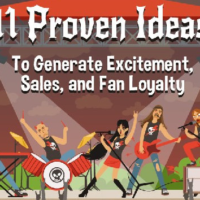Sync Licensing and the Music Business
Joel Jordan is the Founder and President of Synchtank, a New York- and London-based software company that creates powerful cloud software to help rights holders and broadcasters improve catalog management and efficiently organize marketing, licensing and sales processes. Synchtank has hundreds of clients across five continents, from top music publishers and record labels to composers and producers, distributors, managers, advertising agencies, film and TV production companies, broadcast networks, and more, supporting some of the best-known catalogs and largest brands in the world. Joel started well-known punk and hardcore label, Watermark, with his identical twin brother, Jason over 25 years ago, releasing vinyl records out of his parents’ South Jersey basement. This later developed into a diversified master catalog and a prolific joint venture publishing company with Rykomusic. Joel still currently signs new artists to his new publishing company and runs his collectible digital and vinyl-only indie labels, The Savant Guard, Watermark, and Warmth. Joel’s clients include Disney, Sony Pictures, 20th Century Fox, BT Sport, Music Sales, TuneCore/Believe, Silva Screen, Sub Pop, Ghostly, Adult Swim, Red Bull Media House, Cutting Edge, Naxos, peermusic, Format, Position Music, Cuesongs, Bucks, Imagem and many others.

Joel explained how Synchtank came to be and how it helps artists, publishers, labels and creators manage their catalogs. He also talked about the current sync license market and how artists can thrive in the current climate.
MC:
Thanks for taking some time, Joel. Tell me a little bit about Synchtank and the work you’re doing.
JJ:
Synchtank started as a means for me to promote, organize and convey the vastness and value of the catalog I had from a record label that my twin brother and I had started out of my parents’ basement. We really had no vehicle through which to educate anybody about what we were doing outside of download stores, streaming services, social networks and websites that didn’t do much. We were using whatever marketing tools we could, including MailChimp, and Dropbox, but I found that in general, whenever I was trying to promote my catalog, it was creating more work for myself and I wasn’t getting my message across effectively.
As an individual trying to run a record label and a publishing company, I needed a force multiplier – something that would make one person move like ten. While I was sorting out the more specific problem, I just looked what I had to do every single day, whether that was promoting for a retailer, or for a DJ, a club, a radio station, or for sync licensing. I was doing the same things every single day – creating playlists, zip files, newsletters, and emails, and not getting an understanding of where my traction was exactly.
I discovered that sync licensing was my primary pain point. I saw my record sales start to dwindle and saw the opportunities in sync becoming larger and larger for smaller publishing companies like me. I noticed that music supervisors and brands were starting to reach out beyond the major labels. So, I figured this was a good time to try and organize my catalog. In doing so, I created Synchtank. There was nothing else out there like it to do all of the things that I had to do- like organizing the rights, the materials and the other assets all into one place so that all of the information lived together and could be accessed instantly and from anywhere by anyone with the right permissions. There was nothing else out there that I knew of software-wise that enabled me to easily move through my catalog, or that allowed my customers to easily move through my catalog and see everything clearly. In other words, there was no fruit stand for my fruit so I had to build it.
MC:
I want to get into some of the specifics of what Synchtank does. Let’s say you are an artist that has full control of your music; you own the publishing and have the master rights. Do you approach a music supervisor yourself, or does Synchtank help you initiate that outreach?
JJ:
Synchtank absolutely helps you initiate outreach if you have the contacts. It’s meant as a process control piece. So, in putting all the assets in one place, you have your recoding living side by side all with the information about the recording: who wrote it; when it was published; who picks up the money; all the details you would need to know to fill out a license.
Synchtank also helps with the actual delivery and distribution of tracks and playlists to potential buyers, like music supervisors, in a way that helps you convey your brand and messaging more accurately than just using Dropbox. It basically performs all the same functions that Dropbox, iTunes, MailChimp, Spreadsheets and about five other programs do, but from one place, so you don’t have to jump from program to program or create work to link this all together.
In essence, Synchtank goes through the same process you go through when you’re searching and pitching your music. And it is also the same process that anyone who you pitch to would expect. They can search or download any format- MP3, WAV, AIFF, stems, or just stream. It also allows you to measure the success rate of any pitch or person coming through the site, because you can see the specifics of the user activity – opens, clicks, streams, downloads, to understand who to follow up with (or not).
MC:
It seems like you’ve had a lot of success thus far. Who has signed up for your service?
JJ:
Publishers, labels, distributors, managers, composers … pretty much anyone with a music collection. When they come to us, they’ve usually been using whatever is available to showcase their music, like SoundCloud or similar public platforms. But those solutions don’t work well to deliver assets with attached licensing and rights information, because they don’t offer privacy and security beyond the basic settings.
We’ve had a lot of luck with publishers in particular, I think because we really understand their specific problems. When I made the program, I assumed that publishers had all their materials and assets organized and that bigger companies had solutions already available for them, but they really didn’t.
With Synchtank, I’ve been able to go in and show publishers, labels and creative teams how much more quickly they can move through their day by joining up these disparate processes and drive their brand and marketing better at the same time. Synchtank doesn’t do their whole job for them, in the same way that you don’t become a carpenter just because you have a hammer and some nails. In order to effectively use the program, you have to be good at your job in the first place. So we’re not automating people out of jobs, just making them use the limited time they have more efficiently so they can do other things besides sell and pitch – like building their network.
What we’ve done is made a lever to leverage a catalog. And if you can get your arms around the catalog and know your catalog, then the creative team is able to make more deals for the entire catalog, not the top 100 songs. Normally your staff would be tied down by doing all the little bitty, time-consuming tasks that surround promoting a catalog: zipping files; uploading files; writing long emails; making calls; logging every little thing they did. All of those tasks are done automatically through Synchtank and tracked so you can measure and report on the success and outcome later.
To clarify, the people we primarily work with are very large companies that have large amounts of staff and a lot of music or different catalogs. They have the most issues of anyone with managing different sets of rights across different offices, in different languages. They have to deal with different territory restrictions plus all sorts of cultural differences and rules governing the usages of the music. Synchtank has grown into a solution that can be very accommodating to businesses with multiple offices, even though it started in my living room for use by a single publisher. We still offer solutions for individuals and tiny publishers as well, so everyone can make use of the platform whether you’re big or small.
MC:
Do you touch any other sides of the business besides the supply (rights holders)?
JJ:
We have moved into creating rights and asset management solutions for broadcasters, networks and production companies that create TV, Film, Video games and multi media. Usually the broadcasters and the people receiving the music are only getting half the picture. Perhaps they only get the recording, but don’t have access to all the other important data (composition) or the complete set of rights. We’re currently building a solution right now for networks, and we already have a few network clients we work with, like Adult Swim and BT Sport, which is the largest sports network in Europe for football/soccer. The music supervisors need to organize all the music that go into their different programming and comply with the rights that they have before anything is aired. We know all the rights holders and also the specifics of all the rights, which helps enable quicker business transitions. So we are here to help both rights owners and users/buyers on both sides of the transaction.
MC:
Much of what you just said makes me realize you have a very unique perspective on two things that are of great interest to people in the music business right now: the metadata problem; the state of sync licensing.
Do you think that something like blockchain or some other new technology is going to come in and finally solve the problem of how data is handled?
JJ:
The whole industry is relying on data, especially the program we have. So, if you put garbage in, you’ll get garbage out. My program and most others are useless if you put in very little data, because there is then nothing to drive the search engines.
In the past, most data was manually entered, which was arduous work for music publishers and others. They had to keep track of not only all the rights they have for a specific composition, but also all the recordings that exist for that composition.
So, for example, there might be hundreds of versions of “Santa Claus is Coming to Town” or some other similar popular song. If you’re the publisher, you have to track all these recordings, and that makes for a lot of work. There are literally dozens of companies right now taking on that task of uniting the composition information with the actual recordings that exist, including user generated content and cover recordings.
To your point, I’m actually really excited about blockchain and other emerging technologies for data management. There’s Dot Blockchain and Paperchain, a new startup that are both on the cutting edge of creating tools anyone can use to access and validate rights information. There’s also Deep 13, who are incredible at cleaning up metadata and filling in the blanks using a multitude of databases and clever technology. And there are many other companies now that have made it their life’s work to solve the enormous, time-consuming data problem of recording and composition rights needing to be unified.
I’m very hopeful that these startups are going to succeed. Obviously, one or two companies will likely rise to the top and come up with an industry standard solution, and automation/machine learning is really the future of the business. This data lineup problem is one of the last remaining obstacles.
When people ask, “Why doesn’t (insert digital service name here) pay writers?” the answer is usually because the ISRC or the ISWC wasn’t provided, or those two weren’t lined up. We’re working with systems that were developed for selling CDs and physical product, which were not intended to be used for streaming services nor the barrage of user generated content we are seeing online. We’re dealing with mechanical licenses and structures that are outdated for digital products and modern times.
MC:
I imagine the percentage of breakage has to be ungodly large.
JJ:
It’s enormous. We can look to Paperchain for an example. They just recently aligned 43 million orphaned works at the U.S. Copyright Office. That’s 43 million songs for which creators are not identified nor being paid appropriately. Why is that happening? It’s because there’s been nothing but paper until very recently. We’ve had machines not talking to each other. There’s been no centralized authority on where any of this information should live. And, to be fair, BMI an ASCAP have been making historic deals together to make this information more available, so I applaud them.
I also applaud the recent deal with YouTube that allows people to finally share information about works. This openness is what needs to happen. As a comparison, think about when you go to a restaurant: The menu isn’t a secret – the recipe is.
Similarly, metadata shouldn’t be secret. It should be shared, open and useful for everybody, because in the end, what we’re all trying to do is keep the music business afloat, make it bigger and, if possible, make it what it used to be.
Streaming is finally taking off, reaching levels we never thought it would reach. The amount of revenue that’s coming in from streaming alone is starting to make up for the fact that the lucrative CD business doesn’t exist anymore. These massive gains we used to get are now coming in bit-by-bit, but the entire technological background of what the music industry has to deal with has been largely unavailable or just doesn’t exist.
MC:
I want to switch gears a bit and talk about sync. Is that landscape changing? What does that look like now?
JJ:
It’s still growing. It’s currently over a 2 billion dollar business worldwide. In terms of the split between major label and indies, if you look at each different market share, they’re probably skewed one way or another, so I’m not sure exactly who does better in each market. I know the indies have quite a large share of the sync revenue right now, so it’s not strictly a major label game at all.
Music supervisors have a wide variety of labels they can reach out to now. Organizations like A2IM, AIM and Music Biz have leveled the playing field in terms of catalog visibility and availability by connecting catalog owners through meaningful events and conferences. Everybody is eagerly making those relationships that before were reliant on agencies, large publishing companies or large labels with staff to take it on. People were giving these entities the bulk of their business simply because they were the keepers of the well-known songs. If you want something you know, that’s new and a hit, you are going to call Sony or any other major. If you want something that’s not a hit yet or by a band that hasn’t even been on tour before, you’re going to call a publisher and talk to the A&R guys to see what’s up and coming.
That second process involves way more research. And the A&R guys are now much more like the music supervisors because they’re choosing music that might earn more money than a record label deal would.
There’s no way around them. There are music licensing agencies, but obviously the agencies are only good as the work they want to put into it. In the end, as an artist, you’re obviously your own best promoter, but that creates an entirely new job for yourself.
MC:
And do you find that one genre does better than another when it comes to sync?
JJ:
What works well for a film or television show depends on what the brief calls for. There are all sorts of specific requests that only a specific kind of label could fulfill, like ambient music, hardcore metal, etc. But to answer your question, there’s no specific genre that’s outdoing any other, but there are trends from time to time – like analog synths – that pop up off the back of a popular show, like Stranger Things or something else. You’ll start to see mimicking kinds of placements and things like that, simply because the show is familiar.
That being said, a lot of the work is research based on what actually should go against that video, there are music supervisors that just know which songs that would go well for the purpose of what works best for the story.. Some of them have a decree to use a certain era or a certain style or genre or something that’s dependent on the theme of the project they’re working on and will work within set guidelines.
But you could probably look and see a lot of correlation between what’s popular or what’s trending on Spotify and YouTube and what’s on the TV three months later. And music supervisors are onto artists and songs way before they happen, almost like A&R guys themselves, discovering gems for the rest of us, so it’s probably already been on their radar for even longer.
MC:
With all this in mind, in your experience, how can artists get more sync placements?
JJ:
I think the most important thing for artists is to get to know as well as possible the people who might use your music. A blind email to a music supervisor doesn’t help at all. I personally try to answer every email I get, and I don’t even do music supervision. I can’t imagine the volume of cold emails music supervisors are getting hit with that isn’t going to help them at that very second with the project they’re currently working on.
The best way to get more placements is to make sure your music is phenomenal, if it’s not then don’t bother with step two. That is network as much as you can. Make friend show potential partners why you’re different, valuable and what you can offer them. It’s still all about relationships in the music business, and your reputation as an artist and creator is your currency. As long as you’re cool to people, they will be good to you. Obviously, that’s really true for any business.
If you have the opportunity to meet someone and make a connection, and you have great music, then you’re 80% there. The rest is down to luck, specific need and timing.
MC:
Do you have any parting words for artists?
JJ:
The only way to success is to put in the work- make great music first and then the rest will follow.
To learn more about Joel Jordan and the work he does with artists and creators, visit the Synchtank website: https://www.synchtank.com. You can also find the company on Facebook and Twitter.









